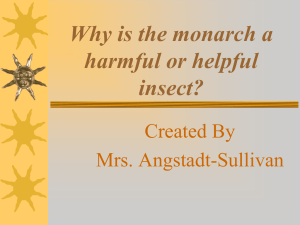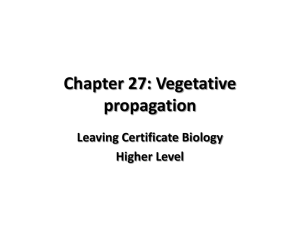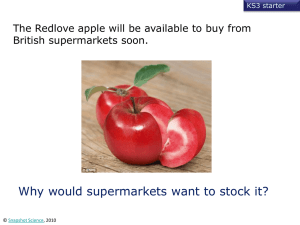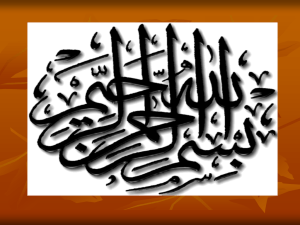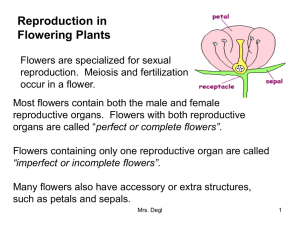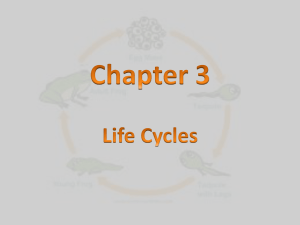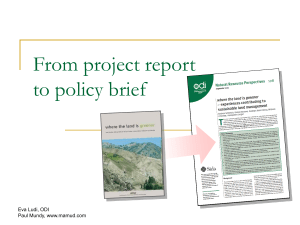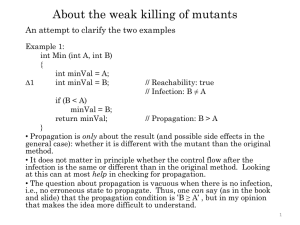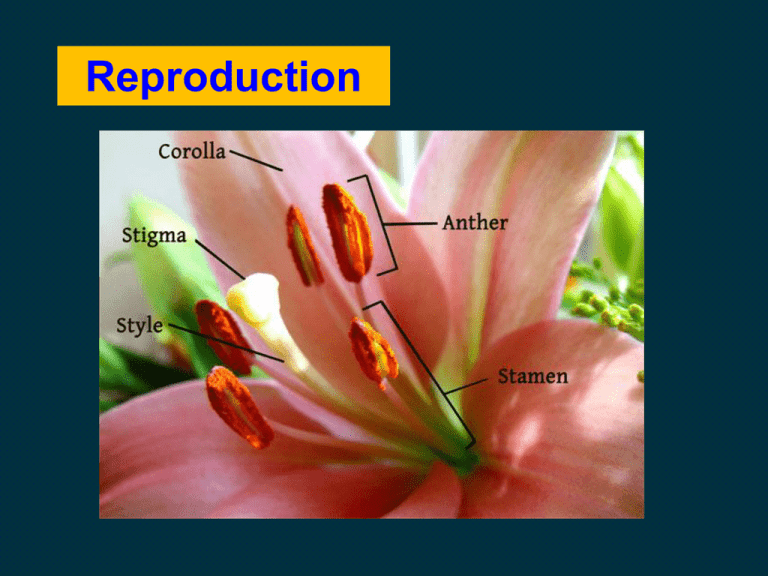
Reproduction
Reproduction
• the process of producing
offspring
• necessary for the
continuation of a species
Two types of reproduction
Asexual
Sexual
Two types of reproduction
Asexual
Sexual
• involves one parent
• involves no gamete (sex
cell)
• offspring are genetically
identical to the parents –
mitotic cell division
• usually involves 2 parents
• involves gametes
• involves fertilization
– fusion of the nuclei of male &
female gametes zygote
• offspring are genetically different
from each of their parents
Types of asexual reproduction
Examples of asexual reproduction
Binary
fission
Budding
Fragmentation
Spore
formation
Vegetative
propagation
Binary
Binary fission
fission
• division of unicellular organisms into equal halves
e.g. Amoeba
Binary
fission
nucleus divides equally
into two by mitosis
nucleus
cytoplasm
constricts
two daughter
Amoebae are
formed
Budding
• production of buds, which grow to new individuals
• e.g. yeast
Budding
nucleus
a yeast cell
a bud is
formed
a nucleus
moves into
the bud
vacuole
nucleus
divides
into two
a nucleus
remains in the
parent cell
Budding
the new cell breaks
off from the
parent cell
Spore
formation
• produced in large numbers.
• occurs in fungi
e.g. Mucor, Rhizopus
Spore
formation
• Fungi are
saprophytescausing rotting
of dead organic
matters
• Produce spores
for reproduction
and dispersal
Fragmentation
e.g. spirogyra
Fragmentation
Amazing power of regeneration in starfish
Fragmentation
Fragmentation
regeneration in flatworm
Vegetative
Vegetative
propagation
propagation
• development of new plants from
vegetative / food storage organs
• occurs in flowering plants
e.g. potato, onion, ginger, Gladiolus
development of new plants from vegetative /
food storage organs
1. Bulb 2. tuber 3. rhizome 4. corm
Vegetative
propagation
storage
organ
bud
aerial
parts
1 When conditions become
unfavourable such as
winter, the aerial parts of
the plant die and the
storage organ stops
growing underground.
It survives through bad
conditions for growth.
Vegetative
propagation
2 When conditions are suitable
for growth, a new plant
develops from a bud.
The storage organ
provides food for the
development of the new
plant.
Vegetative
propagation
3 Adventitious
roots are
formed. They
absorb water
and minerals.
The shoot
grows up and
develops leaves.
adventitious
roots
aerial
shoot
Vegetative
propagation
leaf
4 The storage organ
dries up as food is
used up for growth.
Vegetative
propagation
5 The plant can now survive on
its own by food made from
photosynthesis. Some
food made from
photosynthesis is
passed to a new
storage organ.
previous
storage
organ
new storage
organ
Vegetative
propagation
Examples of storage organs
Tuber
Bulb
Rhizome
Corm
• short
• horizontally
• swollen
• short swollen
underground
growing
underground
underground
stem with
underground
stem
stem
layers of
stem
e.g. potato
e.g.
fleshy ‘scale
tuber
e.g. ginger
Gladiolus
leaves’
rhizome
corm
e.g. onion
bulb
Vegetative
propagation
Tuber
Vegetative propagation of a potato plant
Vegetative
propagation
Tuber
Vegetative propagation of a potato plant
In spring
In winter
1 The aerial shoots die but the
new tubers remain dormant.
2 Each bud can produce a
new independent plant.
tuber formed by
last year’s plant
shoot
In summer
old tuber
new tubers
adventitious roots
3 The buds use the food stored
in the tuber to produce
adventitious roots and shoots.
eye (a bud)
4 Excess food made
in the leaves is sent
to the underground
shoots and stored.
Vegetative
propagation
Tuber
Vegetative propagation of a potato plant
Vegetative
propagation
Bulb
onion bulb
Vegetative
propagation
Bulb
Growth of an onion bulb
scale leaf
fleshy leaf
bud
stem
root
1 The bud remains dormant.
new flower stalk
leaf
fleshy leaf
new bulb
2 After dormancy, the bud develops.
The fleshy leaves provide food for
the development of the shoot.
They become dry scale leaves after
their food storage has been used up.
3 The leaves make and
provide food for the
growth of a new bud.
Vegetative
propagation
Rhizome
Growth of a ginger rhizome
Vegetative
propagation
Growth of a ginger rhizome
Rhizome
The food produced from
photosynthesis passes
downwards to the
underground parts.
Vegetative
propagation
Growth of a ginger rhizome
Rhizome
The food produced from
photosynthesis passes
downwards to the
underground parts.
Food passes upwards
from the older parts to
the growing regions.
lateral bud
grows into
daughter
rhizome
Vegetative
propagation
Corm
Gladiolus
Vegetative
propagation
Corm
Growth of a Gladiolus corm
In spring
bud
scale leaf
remains of last
year’s corm
1 Food stored in the swollen stem is passed
upwards to the bud for its growth.
aerial shoot
leaf
new corm
new corm
old corm
2 When the leaves are
well developed, the food
they made is passed
down to the new corm.
3 A new corm is
developed over
the old one each
year.
Vegetative
propagation
Corm
Vegetative
propagation
Artificial vegetative propagation
• vegetative propagation
done artificially
• can produce desired
varieties quickly
• method: taking of ‘cuttings’
e.g. Coleus (stem),
African violet (leaves)
Artificial propagation by cutting
Artificial Vegetative
reproduction
Importance of Vegetative
Propagation
It is the only means of reproduction for seedless
plants such as pineapples, seedless grapes,
oranges, roses, sugarcane, potato, banana, etc.
Plants raised through vegetative propagation are
genetically similar. It preserves the type of
characters that a plant breeder desires to retain.
It is very economical and easy method for the
multiplication of plants.
Artificial propagation by grafting
Eg. Fruit trees
Ornamental plants
Bauhinia of HK
Grafting is a method of asexual plant propagation where the tissues
of one plant are encouraged to fuse with those of another.
In most cases, one plant is selected for its roots, and this is called the
stock or rootstock. The other plant is selected for its stems, leaves,
flowers, or fruits and is called the scion.
Artificial Vegetative
reproduction
To ensure a quick growth union, all cut surfaces are covered with a soft wax to prevent
drying. The tissues of both the stock and the scion will fuse together and will make
organic connection, getting nourishment from the stock, but producing fruits of scion
retaining parental characters. Grafting is not possible is monocot plants since cambial
activity is essential for the union of stocks and scion.
Grafting blends the properties of two plants. It is also used in the production of dwarf
fruit trees for the home gardens. High quality roses are usually grafted on wild rose root
stocks. Other plants where grafting has been performed successfully are rubber, apple,
pear, mango and guava.
Grafting
peach into plum
Main grafting steps: Trimming
bark after cutting a branch to
be grafted
Next: Budwood inserted into branch
These peach grafts were been successful
and have already produced blossoms
Completed bark graft which has been tied
with tape and waxed with grafting wax
This wild plum tree has now become
half peach and half plum
The ‘grafted’ Bauhinia appear in two segments: the upper half is Bauhinia
blakeana 洋紫荊 and the lower half is Bauhinia purpurea 紅花羊蹄甲. When
you look at the joint carefully, then you will notice that the bark textures on
both halves are significantly different. Also, the leaves on the branches and
those near the foot vary a little bit. When we see the ‘grafted’ Bauhinia,
Bauhinia blakeana is just one of the tree names. Bauhinia purpurea is
another one. (Well, if the foot of this tree does have leaves and flowers, then
it should be labeled with two names!)
What are the
ADVANTAGES and
DISADVANTAGES
of Artificial Propagation ?
Vegetative
propagation
Advantages
Speed?
Good characters?
External agents?
Disadvantages
Vegetative
propagation
Advantages
A relatively quick way
to produce new plants
Good characters are
passed to the
offspring
No external agents or
other plants are
needed
Disadvantages
Overcrowding…..
Diseases in parents…..
Offspring are identical…..
Undesirable characters….
Vegetative
propagation
Advantages
Disadvantages
A relatively quick way
to produce new plants
Overcrowding can occur which
causes competition for resources
Good characters of
the parent are passed
to the offspring
Disease of the parent plants can
easily be transmitted to the
offspring
Offspring have
no new features
No external factors or
other plants are
needed for
reproduction
No new features in offspring to
adapt to any changes in
environmental conditions
Undesirable characters are
passed on to the offspring
Importance of Vegetative
Propagation
It is the only means of reproduction for seedless
plants such as pineapples, seedless grapes,
oranges, roses, sugarcane, potato, banana, etc.
Plants raised through vegetative propagation are
genetically similar. It preserves the type of
characters that a plant breeder desires to retain.
It is very economical and easy method for the
multiplication of plants.
Micro propagation by tissue culture
Tissue culture
Application of tissue culture
Application of tissue culture
Micro propagation of plants
Plant tissue in very small amounts can produce hundreds or thousands of plants
continuously. By using tissue culture methods, millions of plants with the same
genetic characteristics can be obtained.
Improved crop
In crop improvement efforts, pure strains can take six to seven generations of
self-pollination or crosses. Through tissue culture techniques, homozygous plants
can be obtained in a short time by producing haploid plants through pollen
culture, anther or ovaries followed by chromosome doubling.
Production of disease-free plants (virus)
Tissue culture technology has contributed in a plant that is free from viruses. In
plants that have been infected with the virus, the cells in the bud tip (meristem) is
an area that is not infected with the virus. In this way virus-free plants can be
obtained from the meristem.
Genetic transformation
For example, bacterial gene transfer (such as cry genes from Bacillus
thuringiensis) into the plant cells )
20.3 Sexual reproduction in flowering
plants
• flowering plants reproduce sexually by producing flowers
stigma
anther
filament
stamen
style
carpel
petal
ovary
ovule
nectary
sepal
receptacle
• sepals, petals,
stamens and carpels
are attached to this
flower stalk
Structure of a flower
Structure of a flower
Sepals
• make up the outermost
ring (calyx) of a flower
• protect the inner parts of
the flower when it is a
bud
sepal
Petals
petal
• make up the second
ring (corolla) of a flower
• may be brightly-coloured
to attract insects
• nectaries may be present at
the base to produce nectar
which attracts insects
• may have insect guides to lead
insects towards the nectaries
insect guide
Stamens
• male reproductive organs
• filament
anther
consists of 2-4 pollen
sacs inside which pollen
grains are formed
supports
anther
anther
when anthers ripen
pollen
sacs
filament
pollen sacs
split open to
release pollens
which contain
male gametes
Carpels
stigma style
• the centre of a flower
• female reproductive
parts
• each consists of
– stigma (receives pollen
grains)
– style (carries the stigma)
– ovary (with ovules inside)
Carpels
• ovules are protected by
integument which has a
small hole (micropyle) ovary wall
• ovules contain the
female gametes ovule
• each ovule is
attached to the
ovary wall by a
stalk
stigma
style
integuments
female
gamete
ovary
micropyle
Structure of a carpel
Pollination
– the transfer of pollen grains from anthers to stigmas
fertilization of male & female gametes in ovules
cross-pollination
self-pollination
1
Pollination
2
wind-pollination
insect-pollination
Cross-pollination and self-pollination
Cross-pollination
– pollen grains are
transferred to a
different plant
Cross-pollination and self-pollination
Self-pollination
– pollen grains are
transferred within the
same plant
Inbreeding (Self-pollination)
Advantages:
1. Preserves well-adapted
genotypes
2. Insures seed set in the
absence of pollinators
Disadvantages:
Decreases genetic variability
Outbreeding (Cross-pollination)
Advantages:
1. Increases genetic variability
2. Strong evolutionary potential
3. Adaptation to changing conditions
4. Successful in long-term
Disadvantages:
1. Can destroy well-adapted genotypes
(offspring are not guaranteed to be
viable)
2. Relies on effective cross-pollination
Wind-pollination and insect-pollination
Wind pollination — pollinated by wind
Insect pollination — pollinated by insects
The flowers are structurally
adapted to pollination.
Wind-pollinated flowers
Insect-pollinated flowers
Structural adaptation of wind-pollinated flowers
scent
nectaries
pollen grain
• large number
• smooth and dry
• light in weight
Structural adaptation of wind-pollinated flowers
scent
nectaries
stigma
• large
• feathery
• projects outside the
flower for picking up
pollen grains from air
Structural adaptation of wind-pollinated flowers
scent
nectaries
pollen grain
stigma
petal
• small
• green or dullcoloured
Structural adaptation of wind-pollinated flowers
scent
nectaries
petal
pollen grain
anther
stigma
• hangs outside the
flower, exposed to
wind
• loosely attached to
filament so that light
wind can shake it
Structural adaptation of insect-pollinated flowers
scent
nectaries
pollen grains
of this flower
stick onto the
leg of the bee
pollen grain
• smaller
number
• rough and
sticky/
with hooks
• heavier
Structural adaptation of insect-pollinated flowers
scent
nectaries
stigma
• smaller
• sticky
• remains inside
the flower
pollen grain
Structural adaptation of insect-pollinated flowers
scent
nectaries
stigma
pollen grain
petal
• larger
• brightlycoloured
Structural adaptation of insect-pollinated flowers
scent
nectaries
stigma
anther
• inside the flower
where insects will
brush against it
• firmly attached to
prevent from being
torn away by
insects
pollen grain
petal
Outbreeder or Inbreeder?
Often one can tell just by looking at a flower whether it crosspollinates or self-pollinates.
OUTBREEDER
self-incompatibility
Size of flowers
colors
nectaries
scent
nectar guides
anthers position
Number of pollen grains
style position
INBREEDER
Outbreeder or Inbreeder?
Often one can tell just by looking at a flower whether it crosspollinates or self-pollinates.
OUTBREEDER
INBREEDER
self-incompatible
self-compatible
large flowers
small flowers
bright colors
mono-colored
nectaries present
nectaries absent
scented flowers
unscented flowers
nectar guides present
nectar guides absent
anthers far from stigma
anthers close to stigma
many pollen grains
fewer pollen grains
style not included in flower
style included in flower
Fertilization
1 Pollen grains land
on the stigma of
the same species.
style
flower stalk
sepal
The growth of pollen tube and fertilization
Fertilization
2 Sugary solution at the tip
of the stigma stimulates
the pollen grain to develop
a pollen tube.
style
flower stalk
sepal
The growth of pollen tube and fertilization
Fertilization
3 Pollen tube grows down the
style and eventually into the
ovary by secreting enzymes
to digest tissues of the style.
The male gamete moves
towards the ovule.
style
male
gamete
flower stalk
sepal
The growth of pollen tube and fertilization
Fertilization
4 After growing into the ovary,
the tube grows through the
micropyle of the ovule and
the tip of the tube bursts to
release the male gamete
into the ovule.
style
ovule
ovary
male
gamete
flower stalk
sepal
micropyle
The growth of pollen tube and fertilization
Fertilization
5 The male gamete enters the
ovule and fuses with the
female gamete to form a
zygote.
style
ovule
ovary
male
gamete
flower stalk
sepal
micropyle
The growth of pollen tube and fertilization
20.4 What happens to the floral parts
after fertilization?
wither and
drop off
stamen
sepal
petal
A Bauhinia flower
after fertilization
remains of stigma
and style
scar
integument
seed
coat
ovary
wall
fruit
wall
ovule
seed
ovum
embryo
Fruit(pod) splits
open to two halves
Fruits and seeds
Fruit
consists of
fruit wall
protects
seed
helps
plant dispersal
made up of
seed
coat
protects undeveloped provides
plant embryo food
food
store
Fruits and seeds
Structure of a mung bean seed
micropyle
– a hole through which
embryo absorbs water
before it germinates
seed coat
– surrounds the embryo
and protects it from
damage and against
attack of microorganisms such as
bacteria and fungi External appearance
hilum
– a scar on the
surface of the
coat; formed
when the ovule
detaches from
the ovary wall
Structure of a mung bean seed
plumule
– develops into
the shoot
radicle
– develops into
the root
embryo
cotyledons
Embryo cut opened
– act as food stores
– contain starch and
proteins to supply
food for the plumule
and radicle to develop
Dispersal of seeds and fruits
Why seeds and fruits
have to be dispersed to
distances far away
from parents ?
To reduce
overcrowding and
competition for
materials.
To colonize new areas
which are suitable for
seed germination and
survival of species.
Dispersal
wind dispersal
animal dispersal
adaptive features of fruits and seeds are
• small
• light
• may have
wings/feathery
hair
• brightly-coloured
• sweet, juicy and
good to eat
• may have hooks
Concept diagram
Reproduction
can be
asexual
reproduction
sexual
reproduction
Concept diagram
asexual
reproduction
can be by
binary
fission
budding
vegetative
propagation
artificially
achieved by
by the formation of
stem
tuber
bulb
spore
formation
rhizome
corm
cutting
Concept diagram
in flowering
plants
sexual
reproduction
forms
in mammals
involves
by
flower
after
male
gamete
female
gamete
pollination
and
fusion is
called
for
fertilization
fertilization
copulation
or IVF
Concept diagram
fertilization
fertilization
produces
fruit
contains
seeds
forms
zygote
develops
into
protect
embryo
finally
into
new
organism
for
copulation
or IVF
if no
fertilization
occurs
menstruation
repeats
in
menstrual
cycle
if
fertilization
occurs
pregnancy
prevented
by
contraceptive
methods

